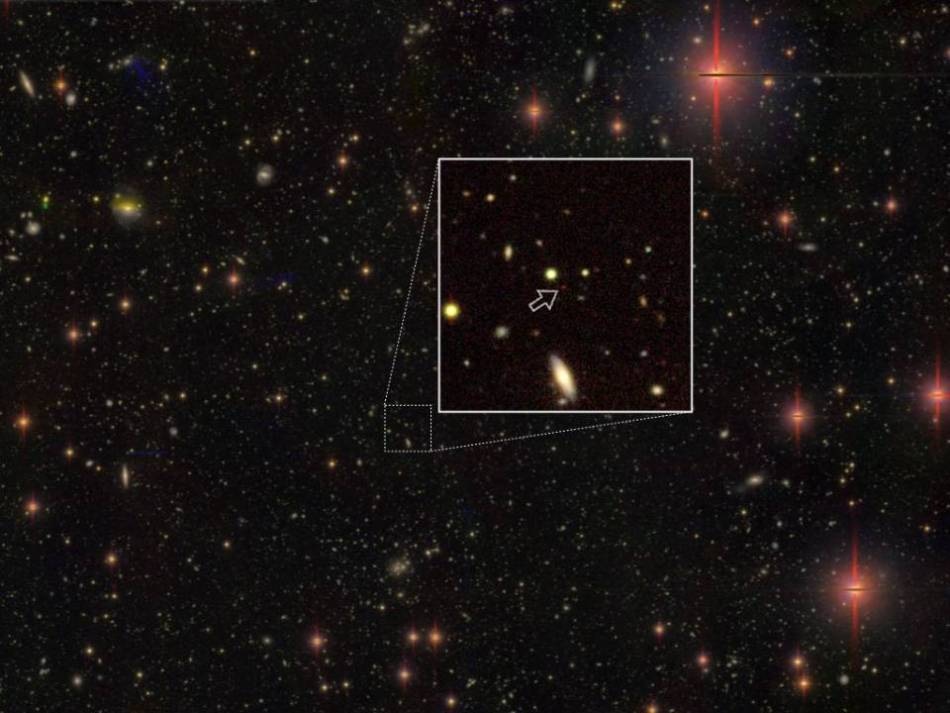Mar 14 2019
Astronomers from Princeton University, Japan, and Taiwan have discovered 83 quasars driven by supermassive black holes in the remote universe, from a period when the universe was less than 10% of its current age.
 Light from one of the most distant quasars known, powered by a supermassive black hole lying 13.05 billion light-years away from Earth. The image was obtained by the Hyper Suprime-Cam (HSC) mounted on the Subaru Telescope. The other objects in the field are mostly stars in our Milky Way or galaxies along the line of sight. (Image credit: the National Astronomical Observatory of Japan)
Light from one of the most distant quasars known, powered by a supermassive black hole lying 13.05 billion light-years away from Earth. The image was obtained by the Hyper Suprime-Cam (HSC) mounted on the Subaru Telescope. The other objects in the field are mostly stars in our Milky Way or galaxies along the line of sight. (Image credit: the National Astronomical Observatory of Japan)
It is remarkable that such massive dense objects were able to form so soon after the Big Bang. Understanding how black holes can form in the early universe, and just how common they are, is a challenge for our cosmological models.
Michael Strauss, Study Co-Author and Professor, Department of Astrophysical Sciences, Princeton University.
This latest breakthrough significantly increases the number of black holes known at that era, and for the first time, shows how common they are early in the history of the universe. The study also offers a new understanding of the impact of black holes on the gas’ physical state in the early universe in its initial billion years. The study has been featured in a series of five papers reported in the Publications of the Astronomical Observatory of Japan and The Astrophysical Journal.
Present at the galaxies’ centers, supermassive black holes can be millions or even billions of times bigger than the sun. Although supermassive black holes are prevalent these days, there is no clear evidence of their initial formation and how many of them actually existed in the early distant universe. When gas accretes onto a supermassive black hole, it becomes visible and shines as a “quasar.” Earlier researches have been sensitive only to the rarest and most luminous quasars, and thus the biggest black holes. The recent discoveries explore the number of fainter quasars, driven by black holes that have masses similar to a majority of black holes observed in the current universe. The researchers applied data obtained with a state-of-the-art instrument, called “Hyper Suprime-Cam” (HSC), placed on the Subaru Telescope of Japan’s National Astronomical Observatory of Japan, on the summit of Maunakea in Hawaii.
HSC has an enormous field-of-view—as much as 1.77 degrees across, or seven times the area of the entire moon—placed on one of the world’s biggest telescopes. The HSC research team is exploring the sky over the duration of 300 nights of telescope time, spread over a period of five years.
From the sensitive HSC survey data, the researchers chose distant quasar candidates and subsequently performed a robust observational campaign to attain spectra of those quasar candidates, with the help of three telescopes—the Gemini South Telescope in Chile, the Gran Telescopio Canarias on the island of La Palma in the Canaries, Spain; and the Subaru Telescope. Through this survey, 83 formerly unknown, extremely distant quasars were discovered. Along with 17 quasars previously known in the survey area, the team discovered that there is approximately one supermassive black hole for each cubic giga-light-year—to put it in simpler words, if the universe is chunked into imaginary cubes that are a billion light-years on one side, each would be able to accommodate a single supermassive black hole.
The quasar sample in this work is roughly 13 billion light-years away from the planet Earth; that means, people are visualizing them as they existed approximately 13 billion years ago. With the occurrence of the Big Bang 13.8 billion years ago, people are effectively looking back in time, visualizing these supermassive black holes and quasars as they emerged just around 800 million years following the creation of the (known) universe.
It was well known that the hydrogen present in the universe was once neutral, but was “reionized”—that is, broken into its component electrons and protons—about the time of the birth of the first-generation of galaxies, stars, and supermassive black holes, all in the initial few hundred million years following the Big Bang. While this is indeed a breakthrough in cosmic history, astronomers were still clueless about what exactly provided the remarkable amount of energy needed to induce the reionization. According to a convincing theory, many more quasars existed in the early universe than previously identified, and it is their built-in radiation that reionized the universe.
However, the number of quasars we observed shows that this is not the case. The number of quasars seen is significantly less than needed to explain the reionization.
Robert Lupton, Senior Research Scientist, Department of Astrophysical Sciences, Princeton University.
Lupton is also a 1985 PhD alumnus of the Princeton University.
As a result, reionization was induced by another energy source, most probably various galaxies that began to form in the young universe.
The current research was made possible, thanks to Subaru and HSC’s world-leading survey abilities.
“The quasars we discovered will be an interesting subject for further follow-up observations with current and future facilities,” stated Yoshiki Matsuoka, former Princeton postdoctoral researcher and currently at Ehime University in Japan, who headed the research. “We will also learn about the formation and early evolution of supermassive black holes, by comparing the measured number density and luminosity distribution with predictions from theoretical models.”
On the basis of the results obtained to date, the researchers are looking forward to discovering yet more distant black holes and eventually finding when the initial supermassive black hole emerged in the universe.